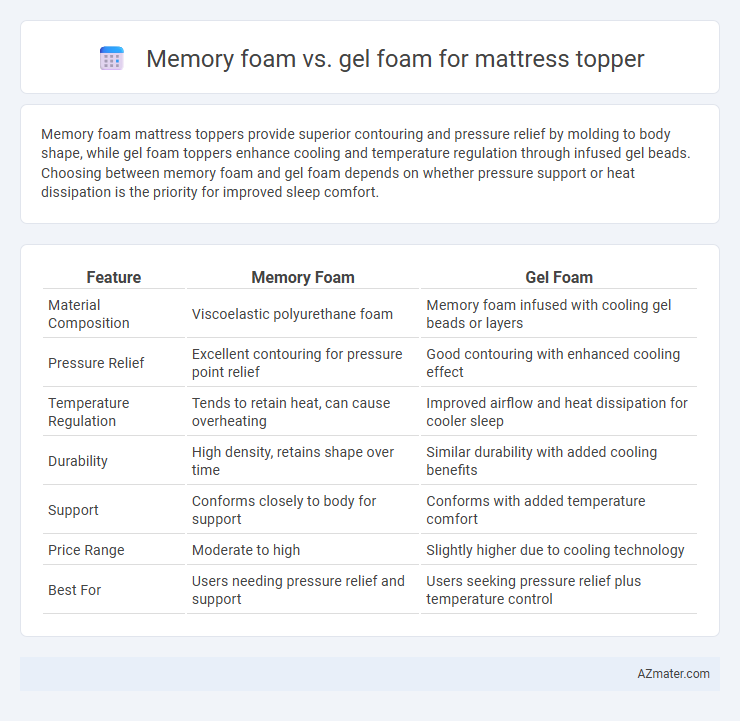Memory foam mattress toppers provide superior contouring and pressure relief by molding to body shape, while gel foam toppers enhance cooling and temperature regulation through infused gel beads. Choosing between memory foam and gel foam depends on whether pressure support or heat dissipation is the priority for improved sleep comfort.
Table of Comparison
| Feature | Memory Foam | Gel Foam |
|---|---|---|
| Material Composition | Viscoelastic polyurethane foam | Memory foam infused with cooling gel beads or layers |
| Pressure Relief | Excellent contouring for pressure point relief | Good contouring with enhanced cooling effect |
| Temperature Regulation | Tends to retain heat, can cause overheating | Improved airflow and heat dissipation for cooler sleep |
| Durability | High density, retains shape over time | Similar durability with added cooling benefits |
| Support | Conforms closely to body for support | Conforms with added temperature comfort |
| Price Range | Moderate to high | Slightly higher due to cooling technology |
| Best For | Users needing pressure relief and support | Users seeking pressure relief plus temperature control |
Introduction to Memory Foam and Gel Foam
Memory foam is a viscoelastic material known for its ability to contour closely to the body, providing excellent pressure relief and support by responding to heat and weight. Gel foam incorporates cooling gel beads or swirls within the memory foam to enhance temperature regulation, reducing heat retention for a cooler sleep experience. Both materials improve mattress comfort, with gel foam specifically designed to address memory foam's tendency to retain heat.
What is Memory Foam?
Memory foam is a viscoelastic material known for its high-density polyurethane composition that responds to body heat and pressure, providing personalized contouring and support. It reduces motion transfer and alleviates pressure points, making it ideal for enhancing mattress comfort and spinal alignment. Compared to gel foam, memory foam tends to retain more heat, though advancements like gel-infused memory foam aim to improve temperature regulation.
What is Gel Foam?
Gel foam is a type of memory foam infused with gel beads or swirls designed to enhance cooling and temperature regulation in mattress toppers. Unlike traditional memory foam, gel foam disperses heat more effectively, reducing the risk of overheating during sleep. This advanced material maintains the pressure-relieving comfort of memory foam while offering improved breathability and a cooler sleep surface.
Key Differences Between Memory Foam and Gel Foam
Memory foam mattress toppers conform to body shape by reacting to heat and pressure, offering targeted support and pressure relief, whereas gel foam mattress toppers incorporate gel beads or layers that enhance cooling properties and improve breathability. Memory foam tends to retain heat, potentially causing discomfort for hot sleepers, while gel foam's temperature-regulating gel infusion helps dissipate heat and maintain a cooler sleep surface. Durability varies, with gel foam generally providing better resilience and preventing sagging over time compared to traditional memory foam.
Comfort and Pressure Relief Comparison
Memory foam mattress toppers provide excellent contouring by conforming to the body's shape, delivering superior pressure relief and reducing pain in sensitive areas like hips and shoulders. Gel foam toppers incorporate cooling gel technology that enhances temperature regulation, preventing heat retention while maintaining comparable comfort and support. Choosing between memory foam and gel foam depends on prioritizing either maximum pressure relief with heat retention or enhanced cooling with slightly firmer support.
Temperature Regulation and Cooling Ability
Memory foam mattress toppers excel in conforming to body shape but tend to retain heat due to their dense structure, which can cause discomfort during warm nights. Gel foam mattress toppers incorporate cooling gel beads or layers designed to enhance airflow and dissipate heat, providing superior temperature regulation and a cooler sleeping surface. Consumers seeking effective moisture wicking and heat dispersion benefit more from gel-infused foams, which maintain a balanced and comfortable sleeping temperature.
Durability and Longevity
Memory foam mattress toppers offer excellent durability due to their dense viscoelastic structure, maintaining shape and support for 5 to 7 years under regular use. Gel foam toppers incorporate cooling gel beads or swirls that enhance breathability but may have slightly less longevity, averaging 3 to 5 years before noticeable wear. Choosing a topper with high-density foam and quality gel infusion optimizes lifespan and sustained comfort in daily sleep conditions.
Motion Isolation and Support
Memory foam excels in motion isolation by absorbing movement and preventing it from transferring across the mattress, making it ideal for couples. Gel foam enhances support with its cooling properties while also offering moderate motion isolation by conforming to body contours. Both materials provide pressure relief, but memory foam typically offers superior motion isolation and support balance for restless sleepers.
Price and Value Considerations
Memory foam mattress toppers generally offer a more affordable price point compared to gel foam options, making them a popular choice for budget-conscious shoppers. Gel foam toppers, infused with cooling gel particles, typically demand a higher price but provide enhanced temperature regulation and durability, potentially delivering greater long-term value. Evaluating costs relative to features and personal comfort needs helps determine the best investment between memory foam and gel foam mattress toppers.
Which Foam is Best for Your Mattress Topper Needs?
Memory foam mattress toppers provide excellent contouring support by adapting to body shape and relieving pressure points, ideal for individuals seeking pain relief and improved spinal alignment. Gel foam toppers offer enhanced cooling properties by dissipating heat more effectively, making them suitable for hot sleepers or those who prefer a cooler sleeping surface. Choosing between memory foam and gel foam depends on whether your priority is deep comfort and support or temperature regulation and breathability in a mattress topper.

Infographic: Memory foam vs Gel foam for Mattress topper
 azmater.com
azmater.com